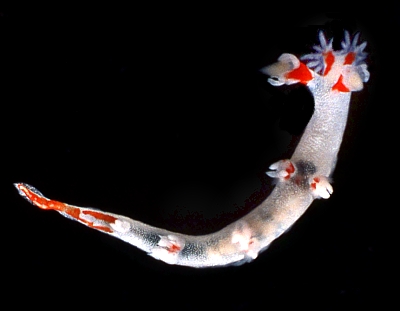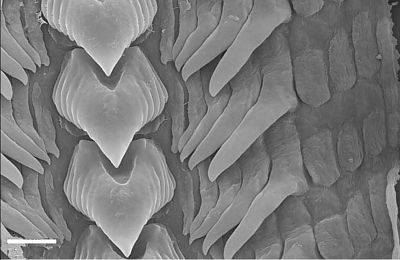

Bornella pele
Pola, Rudman & Gosliner, 2009
Order: NUDIBRANCHIA
Suborder: DENDRONOTINA
Family: Bornellidae
DISTRIBUTION
Tropical Indo-West Pacific [ Hawaii, Japan and northeastern Australia. - Pola et al, 2009; Reunion Id., Indian Ocean - see Forum message]
PHOTO
Upper: AM C. 137536, Australia, Queensland, Great Barrier Reef, 12° 5 S, 143° 58 E, near corner of Wreck Bay Reef, on rubble in deep hole in very exposed reef, 17 mm preserved, 12 December 1982, coll: I. Loch. Photo: I. Loch. Lower: Scanning electron Scanning electron micrograph of Bornella pele (CASIZ 086356). Right half-rows of radular teeth, scale bar:
10µm. SEM Photo: M. Pola.
The animal has an elongate shape typical of species of Bornella, with lobe-like digitate oral tentacles on each side of the mouth, a pair of large elongate rhinophore sheaths and a series of paired dorso-ventral processes down the body. The general body colour is translucent white with scattered subepithelial opaque white granules. There are two parallel red marks on the basal inner side of each dorsolateral process and a similar pair of marks on the rhinophore sheaths, where they may merge into a large patch. There
is also a pair of red bands on the head running from the oral tentacles to the base of the rhinophore sheaths. Another irregular, elongate red band runs along the dorsal midline, from behind the last pair of dorsolateral processes to the posterior tip of the foot. In many cases the anterior half of this band divides into a pair of outer bands.
The rhinophore sheath has three elongate anterior and anterolateral papillae spaced around its upper edge, and there is a fourth, taller, posterior papilla, which is distinctly bifid. Behind the rhinophores, there are three pairs of dorso-lateral processes, followed by two single processes in the dorsal midline. Each dorso-lateral process has a stout base topped with three papillae, all pointed at the tip. There are two bipinnate translucent gills on the inner surface of each of the paired dorso-lateral processes. The bases of the most posterior pair of dorso-lateral processes are joined.
This species is named after the Hawaiian goddess “Pele”, goddess of fire, lightning and volcanoes and refers to the red splashes of colour.
The living adults are small, up to 20 mm in length.
- Pola, M., Rudman, W. B. & Gosliner, T. M. (2009) Systematics and preliminary phylogeny of Bornellidae (Mollusca: Nudibranchia: Dendronotina) based on morphological characters with description of four new species. Zootaxa, 1975, 1-57.
Rudman, W.B., 2009 (January 23) Bornella pele Pola, Rudman & Gosliner, 2009. [In] Sea Slug Forum. Australian Museum, Sydney. Available from http://www.seaslugforum.net/factsheet/bornpele
